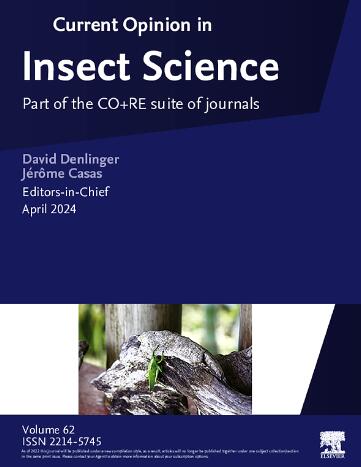有益土壤微生物作为植物-昆虫相互作用的驱动因素:一个视角。
IF 4.8
1区 农林科学
Q1 BIOLOGY
引用次数: 0
摘要
植物与丛枝菌根真菌(AMF)和促进植物生长的根瘤菌(PGPR)等有益土壤微生物的结合可以促进植物的生长和营养吸收,同时改变植物的生长速度、结构、营养质量、次生代谢物、植物激素和挥发性有机化合物(VOCs)等性状,这些性状是与害虫及其天敌相互作用所必需的。微生物对食草昆虫及其天敌的影响可能是积极的、中性的或消极的,并且依赖于环境,因此需要继续综合已发表的研究,以识别新出现的模式,认识局限性,并指导未来的研究。这一观点从应用研究的角度强调了有益土壤微生物驱动农业植物、害虫及其天敌之间相互作用的三个关键途径:(1)植物生长速度、结构和营养质量的改变;(2)植物次生代谢物和植物激素的修饰;(3)挥发性有机物排放的变化。总结了现有的局限性,包括不一致和上下文依赖的结果,并概述了未来的研究领域。最后,这一观点强调有必要了解作物育种、驯化和气候变化相关的压力因素是如何单独和组合地形成这些相互作用的结果的。解决这些限制将确保以微生物为基础的病虫害管理战略成为生产者可用于减少农药使用、保护作物免受生物和非生物胁迫以及可持续地提高作物生产力的可靠工具。本文章由计算机程序翻译,如有差异,请以英文原文为准。
Beneficial soil microbes as drivers of plant–insect interactions: a perspective
The association of plants with beneficial soil microbes, including arbuscular mycorrhizal fungi and plant growth-promoting rhizobacteria, can enhance plant growth and nutrient uptake while modifying plant traits, including growth rate, architecture, nutritional quality, secondary metabolites, phytohormones, and volatile organic compounds (VOCs), necessary for interactions with insect pests and their natural enemies. Microbe-induced effects on insect herbivores and their natural enemies can be positive, neutral, or negative, and are context-dependent, creating the need for continued synthesis of published research to identify emerging patterns, recognize limitations, and guide future research. This perspective highlights three key pathways through which beneficial soil microbes drive interactions among agricultural plants, insect pests, and their natural enemies through the lens of applied research: (1) alterations in plant growth rate, architecture, and nutritional quality; (2) modifications of plant secondary metabolites and phytohormones; and (3) modifications in the emissions of VOCs. Existing limitations, including inconsistent and context-dependent outcomes, are summarized, and future research areas are outlined. Finally, this perspective emphasizes the need to understand how crop breeding, domestication, and climate change–associated stressors, individually and in combination, shape the outcomes of these interactions. Addressing limitations will ensure that microbe-based pest management strategies become dependable tools that producers can use to reduce pesticide use, protect crops from biotic and abiotic stressors, and sustainably enhance crop productivity.
求助全文
通过发布文献求助,成功后即可免费获取论文全文。
去求助
来源期刊

Current opinion in insect science
BIOLOGYECOLOGYENTOMOLOGY-ECOLOGY
CiteScore
10.40
自引率
1.90%
发文量
113
期刊介绍:
Current Opinion in Insect Science is a new systematic review journal that aims to provide specialists with a unique and educational platform to keep up–to–date with the expanding volume of information published in the field of Insect Science. As this is such a broad discipline, we have determined themed sections each of which is reviewed once a year.
The following 11 areas are covered by Current Opinion in Insect Science.
-Ecology
-Insect genomics
-Global Change Biology
-Molecular Physiology (Including Immunity)
-Pests and Resistance
-Parasites, Parasitoids and Biological Control
-Behavioural Ecology
-Development and Regulation
-Social Insects
-Neuroscience
-Vectors and Medical and Veterinary Entomology
There is also a section that changes every year to reflect hot topics in the field.
Section Editors, who are major authorities in their area, are appointed by the Editors of the journal. They divide their section into a number of topics, ensuring that the field is comprehensively covered and that all issues of current importance are emphasized. Section Editors commission articles from leading scientists on each topic that they have selected and the commissioned authors write short review articles in which they present recent developments in their subject, emphasizing the aspects that, in their opinion, are most important. In addition, they provide short annotations to the papers that they consider to be most interesting from all those published in their topic over the previous year.
 求助内容:
求助内容: 应助结果提醒方式:
应助结果提醒方式:


